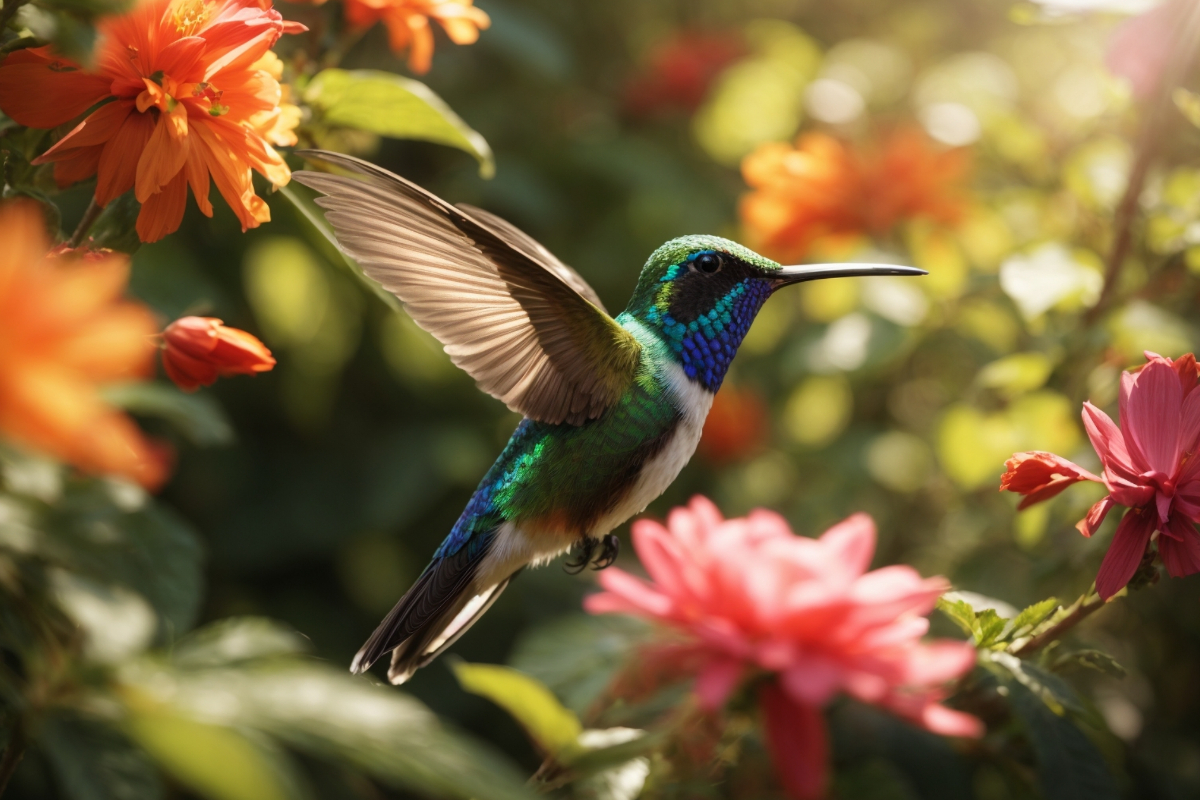Hummingbirds are a blur of motion as they dart from flower to flower, probing blossoms with their slender beaks. This distinctive flight style serves an important purpose – it enables efficient nectar1 feeding to power their dizzying aerial feats!
In this blog, we’ll explore how darting between flowers aids hummingbird foraging success. From expanding access to food sources to conserving energy, you’ll learn why their characteristic movement pattern is key to survival.
Zipping Between Blossoms Boosts Nectar Intake
Hummingbirds need a lot of energy! To keep their tiny bodies fueled, they have to consume more than half their weight in nectar daily.
Darting flight allows hummingbirds to tap into nectar across multiple widely spaced flowers. This maximizes the total amount of sugary fuel they can extract compared to sticking to just one patch of blooms.
Sampling Far and Wide
By rapidly moving between different flower clusters, hummingbirds can take advantage of any newly opened blossoms full of untouched nectar.
It’s like having the inside scoop on where to find the best all-you-can-eat nectar buffets! This is especially handy for migrating hummers that need to quickly locate reliable food sources.
Minimizing Competition
Darting flight also reduces competition with other nectar feeders. Say a bee has staked out a promising patch of flowers.
Rather than waste energy fighting over access, a hummingbird can simply zoom off to the next floral hot spot. This ensures a steady supply of nectar.

Precise Maneuvering Improves Hummingbird’s Feeding Efficiency
Hummingbirds pair their darting travel between flowers with unrivalled hovering stability while feeding. This allows extremely efficient nectar extraction at each blossom.
Total Control
Hummingbirds can maneuver in any direction in flight – even backwards and upside down! This allows them to perfectly position themselves at each flower for the easiest access to nectar.
Compare that to a chickadee that has to land and take off repeatedly to reach different angles on a branch. Darting and hovering save hummingbirds calories they could get from nectar instead.
Built-in Nectar Extraction Tools
Specialised features like forked tongues and beak shapes also complement darting flight by improving nectar uptake. So hummingbirds waste no time or energy switching between travel and feeding.
This seamless transition between darting to flowers and hovering to feed makes the most of their anatomy for maximum foraging efficiency.
Darting Flight Evolved to Aid Feeding
Scientists think hummingbirds’ distinctive flight styles and related adaptations evolved to improve nectar-feeding access.
The first hummingbirds appeared in South America, where an abundance of flowering plants offered a reliable food source. Natural selection favoured better hoverers and darting flight to tap into this bounty.
Over time, anatomical traits like wing articulation and tongue grooves developed to enhance aerial maneuverability and nectar extraction further.
So, by enabling more efficient foraging, darting flight likely conferred a survival advantage. This drove the evolution of supporting adaptations that facilitate hummingbirds’ unparalleled feeding strategy.
Fueling Aerial Mastery
With some of the highest metabolism and energy needs in the animal world, hummingbirds rely on darting flight to maximize nectar consumption.
By rapidly moving between flowers and precisely hovering to feed, they can tap into essential fuel stores. This powers their famous hovering feats, courtship dances, migration marathoners, and gravity-defying escapes.
Final Thought
So next time you spot a hummingbird smoothly transitioning between darting travel and mid-air dining, remember it’s this synergy that enables their extraordinary lifestyle!
Thank you for reading this article. If you’ve found it valuable, we’d be delighted if you could share it with others. Your support means a lot to us. In the meantime, happy bird-watching.
